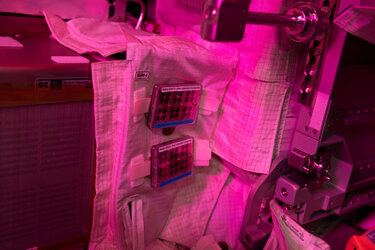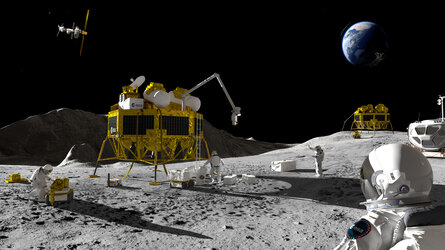Accept all cookies Accept only essential cookies See our Cookie Notice

About ESA
The European Space Agency (ESA) is Europe’s gateway to space. Its mission is to shape the development of Europe’s space capability and ensure that investment in space continues to deliver benefits to the citizens of Europe and the world.
Highlights
ESA - United space in Europe
This is ESA ESA facts Member States & Cooperating States Funding Director General Top management For Member State Delegations European vision European Space Policy ESA & EU Space Councils Responsibility & Sustainability Annual Report Calendar of meetings Corporate newsEstablishments & sites
ESA Headquarters ESA ESTEC ESA ESOC ESA ESRIN ESA EAC ESA ESAC Europe's Spaceport ESA ESEC ESA ECSAT Brussels Office Washington OfficeWorking with ESA
Business with ESA ESA Commercialisation Gateway Law at ESA Careers Cyber resilience at ESA IT at ESA Newsroom Partnerships Merchandising Licence Education Open Space Innovation Platform Integrity and Reporting Administrative Tribunal Health and SafetyMore about ESA
History ESA Historical Archives Exhibitions Publications Art & Culture ESA Merchandise Kids Diversity ESA Brand CentreLatest
Space in Member States
Find out more about space activities in our 23 Member States, and understand how ESA works together with their national agencies, institutions and organisations.
Science & Exploration
Exploring our Solar System and unlocking the secrets of the Universe
Go to topicAstronauts
Missions
Juice Euclid Webb Solar Orbiter BepiColombo Gaia ExoMars Cheops Exoplanet missions More missionsActivities
International Space Station Orion service module Gateway Concordia Caves & Pangaea BenefitsLatest
Space Safety
Protecting life and infrastructure on Earth and in orbit
Go to topicAsteroids
Asteroids and Planetary Defence Asteroid danger explained Flyeye telescope: asteroid detection Hera mission: asteroid deflection Near-Earth Object Coordination CentreSpace junk
About space debris Space debris by the numbers Space Environment Report In space refuelling, refurbishing and removingSafety from space
Clean Space ecodesign Zero Debris Technologies Space for Earth Supporting Sustainable DevelopmentLatest
Applications
Using space to benefit citizens and meet future challenges on Earth
Go to topicObserving the Earth
Observing the Earth Future EO Copernicus Meteorology Space for our climate Satellite missionsCommercialisation
ESA Commercialisation Gateway Open Space Innovation Platform Business Incubation ESA Space SolutionsLatest
Enabling & Support
Making space accessible and developing the technologies for the future
Go to topicBuilding missions
Space Engineering and Technology Test centre Laboratories Concurrent Design Facility Preparing for the future Shaping the Future Discovery and Preparation Advanced Concepts TeamSpace transportation
Space Transportation Ariane Vega Space Rider Future space transportation Boost! Europe's Spaceport Launches from Europe's Spaceport from 2012Latest

Keep this surface dirty
Thank you for liking
You have already liked this page, you can only like it once!
A ‘do not touch’ directive applies to both a Matisse painting and this Matiss experiment on board the International Space Station.
Designed to test the antibacterial properties of hydrophobic (or water-repelling) surfaces on the Station, the sample holders of the upgraded Matiss-2.5 experiment have done their work for roughly a year on board and are now back on Earth for analysis.
Bacteria are a big problem in space as they tend to build up in the constantly-recycled atmosphere of the Space Station. For the six astronauts living in humanity’s habitat in space, keeping the Station clean is an important part of their life to avoid bacteria and fungus. Every Saturday is cleaning day, when the whole crew wipe surfaces, vacuum and collect waste.
Matiss or Microbial Aerosol Tethering on Innovative Surfaces in the international Space Station, driven by French space agency CNES, in collaboration ENS de Lyon and CEA-Leti, and commissioned in 2016 by ESA astronaut Thomas Pesquet, examines the performance of five advanced materials in preventing illness-causing microorganisms from settling and growing in microgravity.
The experiment consists of plaques each containing the five materials to be tested plus a glass control surface. The units are open on the sides to let air flow naturally through and collect any bacteria floating past.
The first set of the Matiss experiment, known as Matiss-1, provided some baseline data points for researchers. Four sample holders were set up in three different locations within the European Columbus laboratory, where they remained for six months.
Once these samples were returned to Earth, researchers characterised the deposits formed on each surface and used the control material to establish a reference for the level and type of contamination expected over half a year.
A continuation of the experiment, known as Matiss-2, saw four identical sample holders containing three different types of material installed in a single location in Columbus. This study aimed to better understand how contamination spreads over time across the hydrophobic and control surfaces. The upgraded Matiss-2.5 aimed to study how contamination spreads, this time spatially, across the hydrophobic surfaces using patterned samples.
The materials are a diverse mix of advanced technology – from self-assembly monolayers and green polymers to ceramic polymers and water-repellent hybrid silica. The smart materials should stop bacteria from sticking and growing over large areas, and effectively making them easier to clean and more hygienic – but which one works best?
Understanding the effectiveness and potential use of these materials will be essential to the design of future spacecraft, especially those carrying humans father out in space.
The findings could also lead to the development and greater use of antimicrobial surfaces on elevator buttons and door handles, in bars, on public transport and in other high-traffic areas.
-
CREDIT
ESA -
LICENCE
ESA Standard Licence

Matiss

MATISS 2.5 experiment on the ISS

Matiss-2 in Columbus

Matiss-2 experiment on the Space Station















 Germany
Germany
 Austria
Austria
 Belgium
Belgium
 Denmark
Denmark
 Spain
Spain
 Estonia
Estonia
 Finland
Finland
 France
France
 Greece
Greece
 Hungary
Hungary
 Ireland
Ireland
 Italy
Italy
 Luxembourg
Luxembourg
 Norway
Norway
 The Netherlands
The Netherlands
 Poland
Poland
 Portugal
Portugal
 Czechia
Czechia
 Romania
Romania
 United Kingdom
United Kingdom
 Slovenia
Slovenia
 Sweden
Sweden
 Switzerland
Switzerland

























